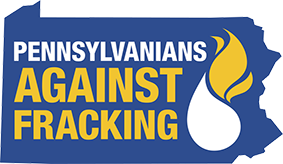For Immediate Release
4/2/2015
For more information:
Karen Feridun, Berks Gas Truth, 610-678-7726
Tracy Carluccio, Delaware Riverkeeper Network, 215-369-1188 x 104
Sam Bernhardt, Food & Water Watch, 267-428-1903
DEP Declares Drought Watch in 27 Counties; PA Against Fracking Asks, “Why Are You Still Allowing Drilling?”
New Infographic Shows Overlap of Drilling and Drought
Harrisburg, Pa: Last week’s declaration of a drought watch in 27 counties announced by the Department of Environmental Protection begs the question of how the Wolf administration can justify the use of millions of gallons of water per day for fracking when drinking water may be in short supply. Pennsylvanians Against Fracking compared the counties included in the watch and found that they are all counties in which drilling has occurred or are in proximity of them. Several key findings below are summarized on a new infographic the coalition has created.
- Of the 27 counties, 18 (Bradford, Cambria, Clinton, Columbia, Indiana, Lackawanna, Lawrence, Luzerne, Lycoming, McKean, Mercer, Potter, Sullivan, Susquehanna, Tioga, Wayne, Westmoreland, and Wyoming) are among the counties where conventional or unconventional drilling operations have occurred since 2003.
- 15 of the 18 (Bradford, Cambria, Clinton, Columbia, Indiana, Lackawanna, Luzerne, Lycoming, McKean, Potter, Sullivan, Susquehanna, Tioga, Wayne, and Wyoming) are in the Susquehanna River Basin.
- The remaining 9 counties (Berks, Carbon, Monroe, Montour, Northumberland, Pike, Schuylkill, Snyder, and Union) are in proximity of the other 18 and are all at least partially in the Susquehanna River Basin.
- Of the 40,893 conventional and unconventional wells drilled since 2003, 17,114 or 42% are in counties under the drought watch.
- Of the 31,863 conventional wells drilled since 2003, 11,772 or 37% are in counties under the drought watch.
- Of the 9,030 unconventional wells drilled since 2003, 5,342 or 59% are in counties under the drought watch.
- Six counties (Bradford, Washington, Susquehanna, Lycoming, Green, and Tioga) account for 71% of unconventional wells. Four of the six (Bradford, Susquehanna, Lycoming, and Tioga) are under the drought watch.
- Five counties (McKean, Warren, Armstrong, Indiana, and Westmoreland) account for 50% of conventional wells. Three of the six (McKean, Indiana, and Westmoreland) are under the drought watch.
- From March 24th, the day the drought watch was put into effect, until April 1, the DEP has issued 50 drilling permits; 18 [Bradford (5), Clearfield (1), Elk (6), Lawrence (3), Lycoming (1), McKean (1), Potter (1)] were issued in counties on the watch list.
The day after the drought watch was declared, National Geographic ran a story called, “Water Use for Fracking Has Skyrocketed, USGS Data Show.” It is the latest in a growing number of reports that look at water use. Last year, Ceres’ report Hydraulic Fracturing & Water Stress: Water Demand by the Numbers found that nearly half of oil and gas wells in the United States are in areas experiencing high or extremely high water stress.
Using data from FracFocus reports acquired by SkyTruth, the Environment America Research and Policy Center extrapolated data on water use to conclude that 30 billion gallons of water were used for drilling across Pennsylvania between 2005 and 2013.[iii]
“In reviewing the drought watch list, we saw the names of many of the counties we know have been hit over and over by drilling operations. Many of them are counties that sit in the Susquehanna River Basin where massive water withdrawals are commonplace. We question the wisdom of allowing depletive drilling operations when drinking water supplies are low. We’re also reminded that no studies were done in Pennsylvania before unconventional drilling began to understand impacts of fracking on our water supply,” said Karen Feridun, Founder of Berks Gas Truth, a PA Against Fracking steering committee member.
“Drinking water is at risk as long as drilling continues because the fresh water used to drill gas wells is consumed and never returned to its source. The enormous volume the drilling industry depletes is either lost deep underground when a well is fracked or turned into a toxic pollutant. If rainfall deficits continue, groundwater levels will continue to fall. Pennsylvania should be pro-active and put the industry on notice that the priority is drinking water and the health of our waterways, and drilling must take a back seat,” said Tracy Carluccio, Deputy Director of Delaware Riverkeeper Network, a PA Against Fracking steering committee member.
Pennsylvanians Against Fracking is a statewide coalition of organizations, institutions, and businesses calling for a halt to fracking in the Commonwealth.
Learn more about Pennsylvanians Against Fracking at paagainstfracking.org.
###
[i] Data on counties under drought watch, well counts, and permit information are taken from DEP data. http://www.depweb.state.pa.us/
[ii] The list of counties in the Susquehanna River Basin was taken from the Susquehanna River Basin Commission’s website, http://www.srbc.net/pubinfo/docs/SRB%20General%205_13%20Updated.pdf
[iii] Fracking by the Numbers: Key Impacts of Dirty Drilling at the State and National Level, Environmental America Research and Policy Center, 2013, p. 23.





